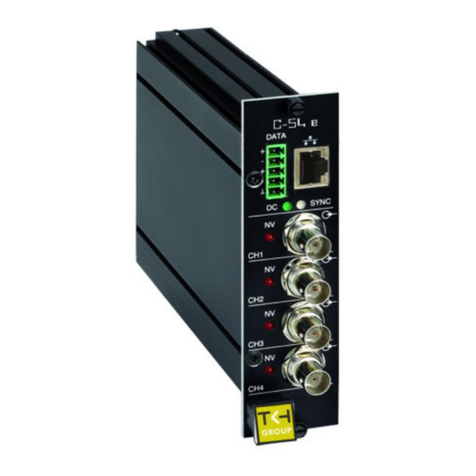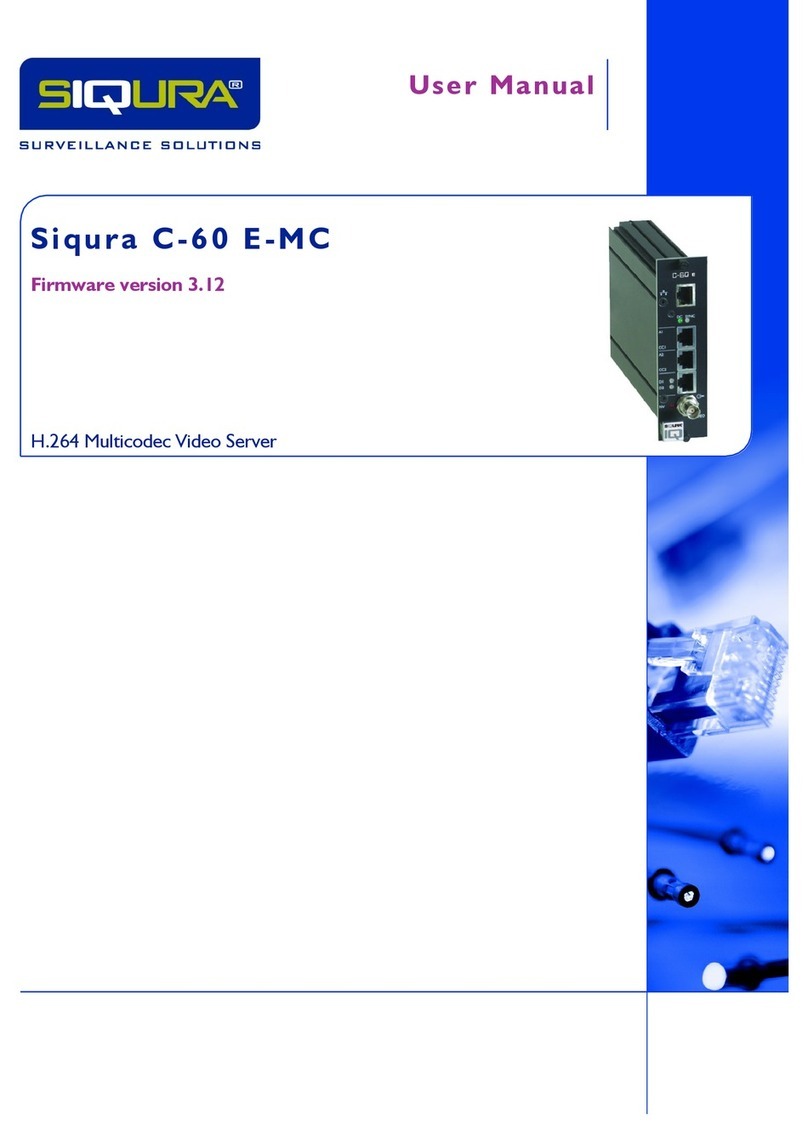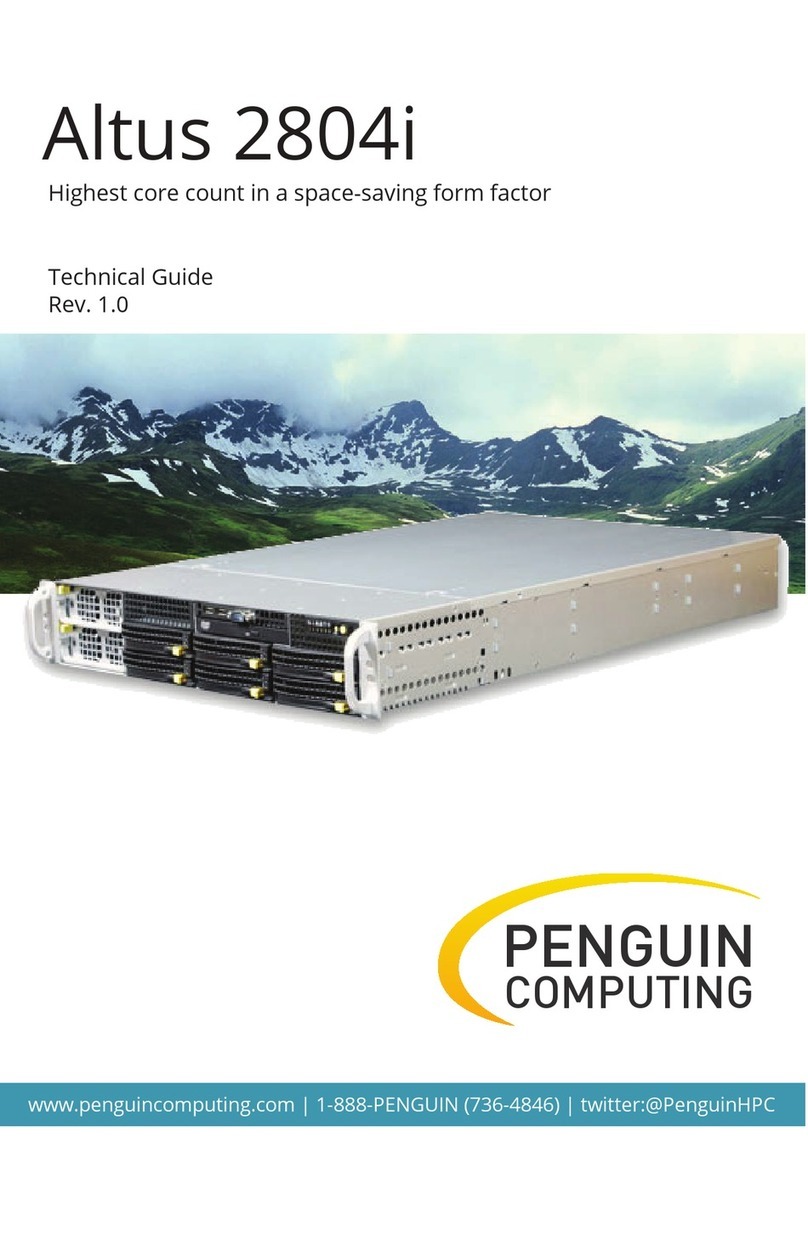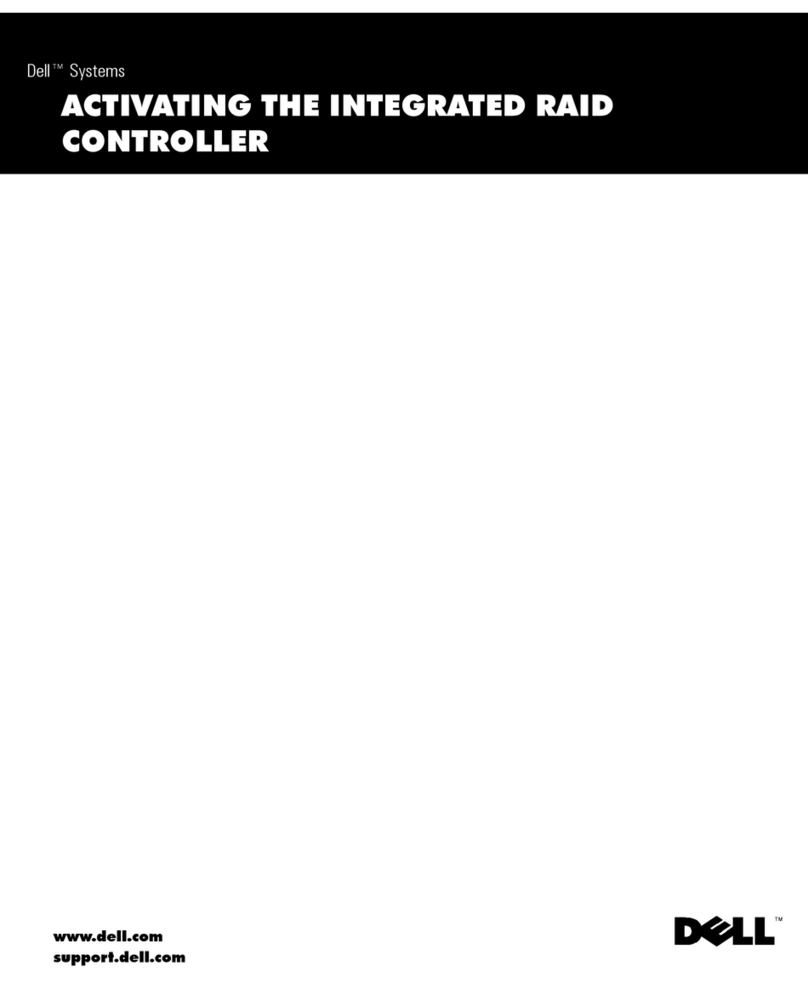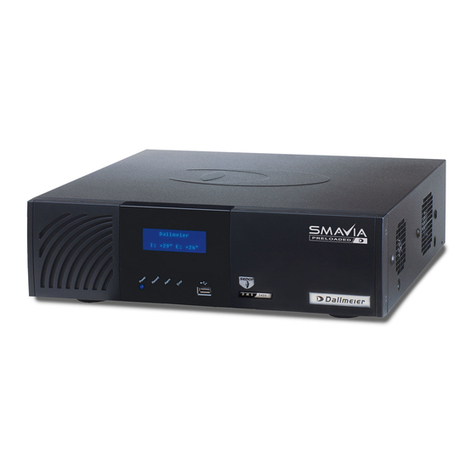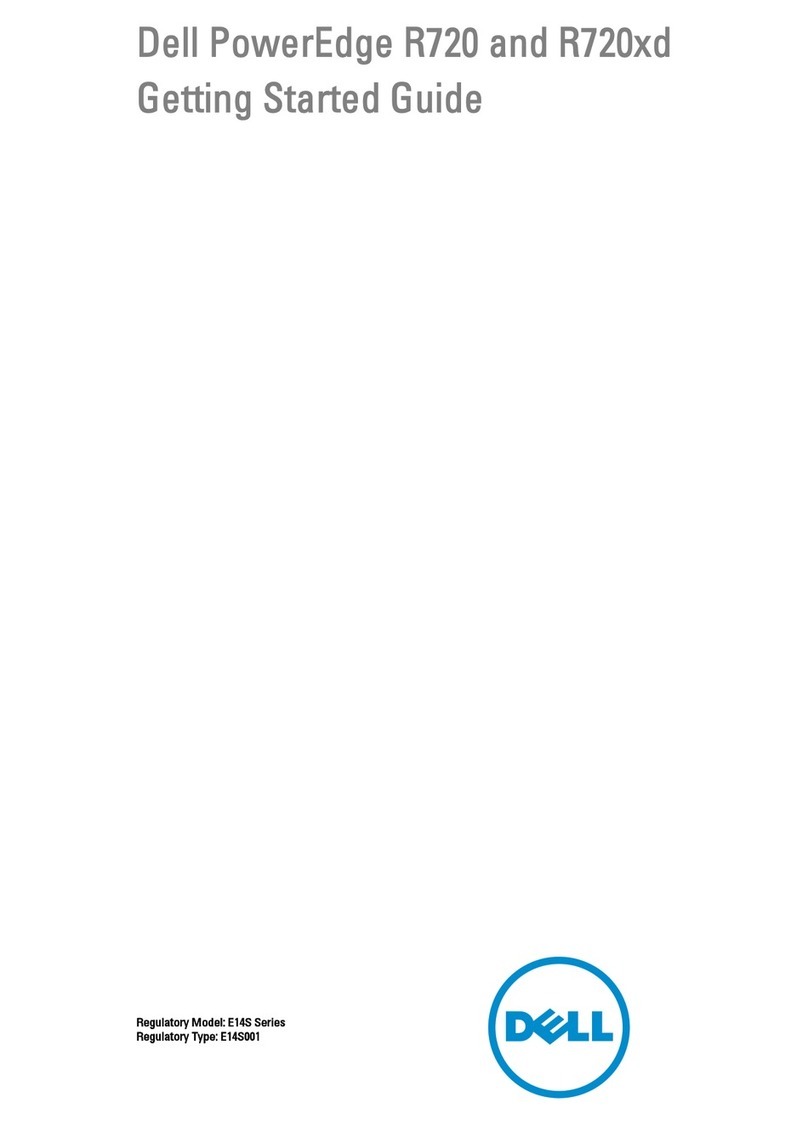Siqura C-60 E-MC User manual

User Manual
U s e r M a n u a l
C-60 E-MC
Firmware Version 4.14
H.264 Multicodec Video Encoder

Page 2
Note: To ensure proper operation, please read this manual thoroughly before using the product and retain the
information for future reference.
Copyright © 2014 Siqura B.V.
All rights reserved.
C-60 E-MC v4.14
User Manual v7 (092606-7)
AIT55MW10
Nothing from this publication may be copied, translated, reproduced, and/or published by means of printing,
photocopying, or by any other means without the prior written permission of Siqura.
Siqura reserves the right to modify specifications stated in this manual.
Brand names
Any brand names mentioned in this manual are registered trademarks of their respective owners.
Liability
Siqura accepts no liability for claims from third parties arising from improper use other than that stated in this
manual.
Although considerable care has been taken to ensure a correct and suitably comprehensive description of all
relevant product components, this manual may nonetheless contain errors and inaccuracies. We invite you to offer
your suggestions and comments by email via t.writi[email protected]. Your feedback will help us to further
improve our documentation.
How to contact us
If you have any comments or queries concerning any aspect related to the product, do not hesitate to contact:
Siqura B.V.
Zuidelijk Halfrond 4
2801 DD Gouda
The Netherlands
General : +31 182 592 333
Fax : +31 182 592 123
E-mail : sales.nl@tkhsecurity.com
WWW : www.siqura.com

Page 3
Contents
1ABOUT THIS MANUAL.............................................................................................................................. 9
2SAFETY AND COMPLIANCE..................................................................................................................... 11
2.1 SAFETY ....................................................................................................................................................11
2.2 DECLARATION OF CONFORMITY....................................................................................................................14
3PRODUCT OVERVIEW............................................................................................................................. 15
3.1 FEATURES ................................................................................................................................................15
3.2 MODELS ..................................................................................................................................................15
3.3 DESCRIPTION ............................................................................................................................................16
3.4 FRONT PANEL ...........................................................................................................................................17
4INSTALL THE UNIT .................................................................................................................................. 19
4.1 POWER THE UNIT.......................................................................................................................................19
4.2 CONNECT CABLES ......................................................................................................................................19
4.3 STARTUP..................................................................................................................................................20
4.4 CONNECTOR PIN ASSIGNMENTS ....................................................................................................................20
4.5 UPDATE DEVICE DEFINITIONS .......................................................................................................................21
5CONNECT THE UNIT ............................................................................................................................... 23
5.1 ESTABLISH A NETWORK CONNECTION.............................................................................................................23
5.2 ESTABLISH VIDEO AND OTHER SIGNAL CONNECTIONS.........................................................................................25
5.2.1 Port numbers....................................................................................................................................26
6INTERFACES ........................................................................................................................................... 27
6.1 ONVIF....................................................................................................................................................27
6.2 OSA .......................................................................................................................................................27
6.3 WEB UI...................................................................................................................................................27
6.4 MX/IP....................................................................................................................................................28
6.5 SNMP ....................................................................................................................................................28
6.6 SAP........................................................................................................................................................28
6.7 NTCIP ....................................................................................................................................................28
7STREAM MEDIA VIA RTSP ...................................................................................................................... 31
7.1 RTSP AND RTP.........................................................................................................................................31
7.2 TRANSFER VIA UDP OR TCP........................................................................................................................32
8ACCESS THE WEBPAGES ......................................................................................................................... 33
8.1 SYSTEM REQUIREMENTS..............................................................................................................................33
8.2 CONNECT VIA WEB BROWSER .......................................................................................................................33
8.3 FIND THE UNIT WITH SIQURA DEVICE MANAGER..............................................................................................33
8.4 CONNECT VIA UPNP ..................................................................................................................................35
8.5 LOG ON TO THE UNIT..................................................................................................................................35
9NAVIGATE THE WEBPAGES .................................................................................................................... 37
9.1 MENU.....................................................................................................................................................37
9.2 ACCESS CONTROL ......................................................................................................................................38
9.3 WEBPAGE ELEMENTS..................................................................................................................................38
10 VIEW LIVE VIDEO VIA BROWSER ............................................................................................................ 39
10.1 ACTIVATE LIVE VIEW ..................................................................................................................................39

Contents
Page 4
10.2 VIEW LIVE VIDEO .......................................................................................................................................40
10.3 USE YOUR BROWSER FOR PTZ CONTROL.........................................................................................................41
11 STATUS .................................................................................................................................................. 43
11.1 VIEW STATUS INFORMATION ........................................................................................................................43
11.1.1 Stream states ...............................................................................................................................43
11.2 VIEW MEASUREMENTS DATA........................................................................................................................44
11.2.1 General, network, and stream measurements ............................................................................44
11.2.2 FTP Push.......................................................................................................................................44
12 NETWORK .............................................................................................................................................. 45
12.1 NETWORK SETTINGS...................................................................................................................................45
12.2 ADVANCED...............................................................................................................................................46
12.2.1 Services ........................................................................................................................................46
12.2.2 Network .......................................................................................................................................46
13 VIDEO .................................................................................................................................................... 47
13.1 VIDEO ENCODING OVERVIEW .......................................................................................................................48
13.2 GENERAL .................................................................................................................................................49
13.2.1 Video Settings ..............................................................................................................................49
13.2.2 Encoder Priorities .........................................................................................................................50
13.3 ENCODER # ..............................................................................................................................................51
13.3.1 Encoder Settings ..........................................................................................................................51
13.3.2 Combinations of settings .............................................................................................................53
13.3.3 Notes............................................................................................................................................54
13.3.4 Make a video connection .............................................................................................................54
13.3.5 Advanced .....................................................................................................................................56
13.3.6 Encoder ........................................................................................................................................56
13.3.7 Stream Manager ..........................................................................................................................59
13.3.8 Transmitter # ...............................................................................................................................60
13.3.9 RTSP Transmitter .........................................................................................................................61
13.3.10 SAP Settings .................................................................................................................................62
13.3.11 Meta data insertion .....................................................................................................................64
13.3.12 Notes............................................................................................................................................66
13.4 H.264 -1................................................................................................................................................68
13.4.1 Encoder Settings ..........................................................................................................................68
13.4.2 Constant Quality Mode configuration .........................................................................................70
13.4.3 Profiles .........................................................................................................................................70
13.4.4 Parameter value combinations....................................................................................................71
13.4.5 MX Transmitter Settings and making video connections.............................................................71
13.4.6 Advanced .....................................................................................................................................72
13.4.6.1 Encoder ...................................................................................................................................................72
13.4.6.2 Stream Manager, Transmitter #, RTSP Transmitter, and SAP..................................................................73
13.5 LIVE VIEW ................................................................................................................................................74
13.5.1 (M)JPEG output............................................................................................................................74
13.5.2 Encoder Settings ..........................................................................................................................74
13.5.3 Advanced .....................................................................................................................................75
13.6 OSD .......................................................................................................................................................76
13.6.1 OSD facilities ................................................................................................................................76
13.6.2 Text Settings.................................................................................................................................76
13.6.3 Text # ...........................................................................................................................................77
13.6.3.1 Advanced.................................................................................................................................................78
13.6.4 Graphics .......................................................................................................................................79
13.6.4.1 Advanced.................................................................................................................................................80
13.7 VMD......................................................................................................................................................81

Contents
Page 5
13.7.1 VMD startup.................................................................................................................................81
13.7.2 Configure detection parameters ..................................................................................................82
13.7.3 Set the mask.................................................................................................................................83
13.7.4 VMD detection window ...............................................................................................................84
13.7.5 VMD alarm...................................................................................................................................84
13.7.6 Advanced .....................................................................................................................................84
13.8 FTP PUSH................................................................................................................................................86
13.8.1 Post JPEG images .........................................................................................................................86
13.8.2 General.........................................................................................................................................86
13.8.3 FTP server.....................................................................................................................................87
13.8.4 Event management......................................................................................................................88
13.8.5 Monitor and troubleshoot FTP Push ............................................................................................88
13.9 IMAGE MONITOR ......................................................................................................................................89
13.9.1 Image quality check .....................................................................................................................89
13.9.2 Enable the Image Monitor ...........................................................................................................90
13.9.3 Dial legend ...................................................................................................................................91
13.9.4 Measurements configuration.......................................................................................................93
13.9.5 Region of Interest (ROI)................................................................................................................94
13.10 TAMPER DETECT ...................................................................................................................................96
13.10.1 Camera movement and scene changes .......................................................................................96
13.10.2 Enable Tamper Detect..................................................................................................................96
13.10.3 Reference images.........................................................................................................................97
13.10.3.1 Create a reference image ...................................................................................................................97
13.10.3.2 Mask the ROI ......................................................................................................................................98
13.10.3.3 Compare images .................................................................................................................................98
13.10.3.4 Delete a reference image ...................................................................................................................99
13.10.4 Position measurement .................................................................................................................99
13.10.5 Alarms........................................................................................................................................100
13.10.5.1 Alarm examples ................................................................................................................................101
13.11 PRIVACY MASK ...................................................................................................................................102
14 AUDIO.................................................................................................................................................. 103
14.1 ENABLE AUDIO ........................................................................................................................................103
14.1.1 Input Settings .............................................................................................................................104
14.1.2 Output Settings ..........................................................................................................................104
14.2 MAKE AUDIO CONNECTIONS ......................................................................................................................105
14.2.1 MX Transmitter Settings ............................................................................................................105
14.2.2 MX Receiver Settings..................................................................................................................106
14.3 ADVANCED.............................................................................................................................................106
14.3.1 Audio Input.................................................................................................................................106
14.3.2 Audio Output..............................................................................................................................106
14.3.3 Audio Encoder ............................................................................................................................107
14.3.4 Audio Decoder............................................................................................................................107
14.3.5 Transmitter # .............................................................................................................................108
14.3.6 Receiver 1...................................................................................................................................109
14.3.7 RTSP Transmitter .......................................................................................................................110
14.3.8 SAP Settings ...............................................................................................................................111
15 DATA RS-422/485 ................................................................................................................................ 113
15.1 GENERAL SETTINGS..................................................................................................................................113
15.2 UART SETTINGS .....................................................................................................................................114
15.3 MAKE DATA CONNECTIONS........................................................................................................................114
15.4 TCP SERVER SETTINGS .............................................................................................................................115
15.5 ADVANCED.............................................................................................................................................116
15.5.1 RS-4xx Settings...........................................................................................................................116

Contents
Page 6
15.5.2 Transmitter # .............................................................................................................................117
15.5.3 Receiver 1...................................................................................................................................118
16 DATA RS-232........................................................................................................................................ 119
16.1 CONFIGURE RS-232 SETTINGS ...................................................................................................................119
17 CC STREAMS ........................................................................................................................................ 121
17.1 CC CHANNELS,CC STATUS,AND ALARMS .....................................................................................................121
17.2 INPUT #SETTINGS ...................................................................................................................................122
17.3 MAKE CONTACT CLOSURE CONNECTIONS......................................................................................................122
17.4 ADVANCED.............................................................................................................................................123
17.4.1 Transmitter # .............................................................................................................................123
17.4.2 Receiver 1...................................................................................................................................123
18 PTZ....................................................................................................................................................... 125
18.1 ENABLE PTZ CONTROL..............................................................................................................................125
18.2 UPLOAD/REMOVE PTZ DRIVERS.................................................................................................................126
18.3 DATA SETTINGS.......................................................................................................................................126
19 SECURITY ............................................................................................................................................. 127
19.1 HTTPS..................................................................................................................................................127
19.2 CERTIFICATE/REQUEST INFORMATION .........................................................................................................128
19.3 CA-ISSUED CERTIFICATE ............................................................................................................................128
19.4 SELF-SIGNED CERTIFICATE..........................................................................................................................129
19.5 OPEN A SECURE CONNECTION ....................................................................................................................129
20 EVENT MANAGEMENT ......................................................................................................................... 131
20.1 ASSOCIATE EVENTS WITH OUTPUT FACILITIES .................................................................................................131
20.1.1 CC Output # ................................................................................................................................132
20.1.2 CC Stream #................................................................................................................................132
20.1.3 FTP Push.....................................................................................................................................133
21 DEVICE MANAGEMENT ........................................................................................................................ 135
21.1 GENERAL ...............................................................................................................................................135
21.1.1 Identification..............................................................................................................................135
21.1.2 Device Name ..............................................................................................................................136
21.1.3 Advanced ...................................................................................................................................136
21.1.3.1 Alarm Settings .......................................................................................................................................136
21.1.3.2 LED control ............................................................................................................................................136
21.2 LOGGING ...............................................................................................................................................137
21.2.1 Log file........................................................................................................................................137
21.2.2 Syslog settings............................................................................................................................137
21.3 SNMP ..................................................................................................................................................138
21.3.1 SNMP System Information .........................................................................................................138
21.3.2 SNMP Communities ...................................................................................................................138
21.3.3 SNMP Agent...............................................................................................................................138
21.3.4 SNMP Traps................................................................................................................................139
21.3.5 Polling ........................................................................................................................................139
21.4 MX ......................................................................................................................................................140
21.4.1 MX/IP .........................................................................................................................................140
21.4.2 MX Notifications ........................................................................................................................140
21.5 AUTO DISCOVERY ....................................................................................................................................141
21.5.1 Advertise the C-60 E-MC ............................................................................................................141
21.5.1.1 Note.......................................................................................................................................................141
21.6 ONVIF..................................................................................................................................................142

Contents
Page 7
21.6.1 Note ...........................................................................................................................................142
21.7 FIRMWARE.............................................................................................................................................143
21.7.1 Firmware images .......................................................................................................................143
21.7.2 Current Version ..........................................................................................................................143
21.7.3 Upgrade .....................................................................................................................................143
21.7.4 Troubleshoot upgrade issues .....................................................................................................144
21.7.5 Advanced ...................................................................................................................................145
21.8 BACKUP/RESTORE ...................................................................................................................................146
21.8.1 Backup .......................................................................................................................................146
21.8.2 Restore .......................................................................................................................................146
21.9 REBOOT.................................................................................................................................................147
22 USER MANAGEMENT ........................................................................................................................... 149
22.1 WEB ACCESS ..........................................................................................................................................149
22.1.1 Access control ............................................................................................................................149
22.1.2 Manage user accounts...............................................................................................................150
22.2 LINUX....................................................................................................................................................151
23 DATE AND TIME ................................................................................................................................... 153
23.1 DATE AND TIME.......................................................................................................................................153
23.2 SNTP SETTINGS ......................................................................................................................................154
23.3 ADVANCED.............................................................................................................................................155
24 MULTICASTING .................................................................................................................................... 157
24.1 MULTICAST ............................................................................................................................................157
24.2 MULTI-UNICASTING .................................................................................................................................158
APPENDIX: ENABLE JAVASCRIPT................................................................................................................... 159
APPENDIX: ENABLE UPNP IN WINDOWS 7 ................................................................................................... 161
APPENDIX: INSTALL A VIDEO PLAYER ........................................................................................................... 163
DOWNLOAD VIDEO PLAYER SOFTWARE......................................................................................................................163
INSTALL QUICKTIME..............................................................................................................................................163
INSTALL VLC........................................................................................................................................................164
APPENDIX: NTCIP CONFIGURATION ............................................................................................................. 165
SUPPORTED CONFORMANCE GROUPS........................................................................................................................165
Configuration...............................................................................................................................................165
CCTV configuration......................................................................................................................................166
Motion control.............................................................................................................................................166
SNMP MIB........................................................................................................................................................166
APPENDIX: TECHNICAL SPECIFICATIONS....................................................................................................... 167


Page 9
C h a p t e r 1
1About this manual
What this manual covers
This manual applies to the C-60 E-MC v4.14, Siqura's H.264 multicodec video server.
It explains:
How to install the unit
How to establish connections
How to communicate with the unit
How to configure the device settings
How to operate the unit
Who should read this manual
This manual is intended for installers and users of the C-60 E-MC.
What you should already know
To be able to install and use the C-60 E-MC properly, you should have adequate knowledge and
skills in the following fields.
Installing electronic devices
Ethernet network technologies and Internet Protocol (IP)
Windows environments
Web browsers
Video, audio, data, and contact closure transmissions
Video compressions methods
Before you start the installation
We advise you to read and observe all instructions and warnings in this manual before you
proceed. Retain this manual with the original bill of sale for future reference and warranty
service. When you unpack your product, check for missing or damaged items. If any item is
missing, or if damage is evident, do not install or operate this product. Contact your supplier for
assistance.
Why specifications may change
At Siqura, we are committed to delivering high-quality products and services. The information
given in this manual was current when published. As we are relentlessly working to improve our
products and user experience, all specifications are subject to change without notice.
We like to hear from you!
Customer satisfaction is our first priority. We welcome and value your opinion about our products
and services. Should you detect errors or inaccuracies in this manual, we would be grateful if you
would inform us. We invite you to offer your suggestions and comments via
t.writing@tkhsecurity.com. Your feedback helps us to further improve our documentation.
Acknowledgement
Siqura units use the open-source Free Type font-rendering library.


Page 11
C h a p t e r 2
2Safety and compliance
This chapter presents the C-60 E-MC safety instructions and compliance information.
In This Chapter
Safety .............................................................................. 11
Declaration of Conformity ................................................... 14
2.1 Safety
The safety information contained in this section, and on other pages of this manual, must be
observed whenever this unit is operated, serviced, or repaired. Failure to comply with any
precaution, warning, or instruction noted in the manual is in violation of the standards of design,
manufacture, and intended use of the module. Siqura assumes no liability for the customer's
failure to comply with any of these safety requirements.
Trained personnel
Installation, adjustment, maintenance, and repair of this equipment are to be performed by
trained personnel aware of the hazards involved. For correct and safe use of the equipment and
in order to keep the equipment in a safe condition, it is essential that both operating and
servicing personnel follow standard safety procedures in addition to the safety precautions and
warnings specified in this manual, and that this unit be installed in locations accessible to trained
service personnel only.
Safety requirements
The equipment described in this manual has been designed and tested according to the
UL/IEC/EN 60950-1 safety requirements. See the CE Declaration of Conformity for compliance
information.
Warning: If there is any doubt regarding the safety of the equipment, do not put it into
operation.
This might be the case when the equipment shows physical damage or is stressed beyond
tolerable limits (for example, during storage and transportation).
Important: Before opening the equipment, disconnect it from all power sources.
The equipment must be powered by a SELV*power supply. This is equivalent to a Limited Power
source (LPS, see UL/IEC/EN 60950-1 clause 2.5) or a "NEC Class 2" power supply. When this
module is operated in extremely elevated temperature conditions, it is possible for internal and
external metal surfaces to become extremely hot.
*SELV: conforming to IEC 60950-1, <60 Vdc output, output voltage galvanically isolated from mains. All
power supplies or power supply cabinets available from Siqura comply with these SELV requirements.

C-60 E-MC
Page 12
Power source and temperature ratings
Verify that the power source is appropriate before you plug in and operate the unit. Use the unit
under conditions where the temperature remains within the range given in the Technical
Specifications of this product.
Optical safety
The following optical safety information applies to C-60 E-MC models with SFP interface only.
This product complies with 21 CFR 1040.10 and 1040.11 except for deviations pursuant to Laser
Notice No. 50, dated June 24, 2007. This optical equipment contains Class 1M lasers or LEDs and
has been designed and tested to meet IEC 60825-1:1993+A1+A2 and IEC 60825-2:2004 safety
class 1M requirements.
Warning: Optical equipment presents potential hazards to testing and servicing personnel, owing
to high levels of optical radiation.
When using magnifying optical instruments, avoid looking directly into the output of an
operating transmitter or into the end of a fiber connected to an operating transmitter, or there
will be a risk of permanent eye damage. Precautions should be taken to prevent exposure to
optical radiation when the unit is removed from its enclosure or when the fiber is disconnected
from the unit. The optical radiation is invisible to the eye.
Use of controls or adjustments or procedures other than those specified herein may result in
hazardous radiation exposure.
The installer is responsible for ensuring that the label depicted below (background: yellow;
border and text: black) is present in the restricted locations where this equipment is installed.
EMC
This device has been tested and found to meet the CE regulations relating to EMC and complies
with Part 15 of the FCC rules. Operation is subject to the following two conditions: (1) This device
may not cause harmful interference, and (2) This device must accept any interference received,
including interference that may cause undesired operation. These limits are designed to provide
reasonable protection against interference to radio communications in any installation. The
equipment generates, uses, and can radiate radio frequency energy; improper use or special
circumstances may cause interference to other equipment or a performance decrease due to
interference radiated by other equipment. In such cases, the user will have to take appropriate
measures to reduce such interactions between this and other equipment.
Any interruption of the shielding inside or outside the equipment could make the equipment
more prone to fail EMC requirements.
Non-video signal lines must use appropriate shielded Cat 5 cabling (S-FTP), or at least an
equivalent. Ensure that all electrically connected components are carefully earthed and
protected against surges (high voltage transients caused by switching or lightning).
ESD
Electrostatic discharge (ESD) can damage or destroy electronic components. Proper precautions
should be taken against ESD when opening the equipment.

Safety and compliance
Page 13
Care and maintenance
The unit will normally need no maintenance. To keep it operating reliably:
Prevent dust from collecting on the unit.
Do not expose the equipment to moisture.
RoHS statement
Global concerns over the health and environmental risks associated with the use
of certain environmentally-sensitive materials in electronic products have led
the European Union (EU) to enact the Directive on the Restriction of the use of
certain Hazardous Substances (RoHS) (2002/95/EC). Siqura offers products
that comply with the EU’s RoHS Directive. The full version of the Siqura RoHS
statement can be viewed at www.siqura.com.
Product disposal
The unit contains valuable materials which qualify for recycling. In the interest
of protecting the natural environment, properly recycling the unit at the end of
its service life is imperative.
When processing the printed circuit board, dismantling the lithium battery calls
for special attention. This kind of battery, a button cell type, contains so little
lithium, that it will never be classified as reactive hazardous waste. It is safe for
normal disposal, as required for batteries by your local authority.

C-60 E-MC
Page 14
2.2 Declaration of Conformity

Page 15
C h a p t e r 3
3Product overview
This chapter introduces the C-60 E-MC and its features.
In This Chapter
Features ........................................................................... 15
Models.............................................................................. 15
Description........................................................................ 16
Front Panel ....................................................................... 17
3.1 Features
C-60 E-MC
1x H.264 and 2x MPEG-2/4/MJPEG encoding
Field-hardened
Image quality monitor
Tamper detection
ONVIF Profile S
Open Streaming Architecture
Fiber and Ethernet over Coax (EoC) option
Motion Adaptive Deinterlacing (M.A.D.™)
Video motion detection
Stereo audio
Duplex serial data
3.2 Models
The Siqura C-60 E-MC series includes the following models.
C-60 E-MC
H.264/MPEG-2/-4/MJPEG video encoder with audio, data, and CC
C-60 E-MC -SFP
Model with empty SFP slot
C-60 E-MC /SA
Stand-alone version of rack-mount models
Rack-mount C-60 E-MC units are designed to be slotted into MC 10 or MC 11 power supply cabinets. Front
panel LEDs indicate network status, stream status (sync), and DC power. All models have backup battery
power for their clocks.

C-60 E-MC
Page 16
3.3 Description
General
The C-60 E-MC combines H.264 video encoding with MPEG-2, MPEG-4 or MJPEG. It offers an
open solution for IP video CCTV applications. The video server features H.264 streaming with
dual-streaming MPEG-2, MPEG-4 or MJPEG, low bandwidth, low latency, and interoperability
with most other systems.
Multicodec and multistreaming
The C-60 E-MC is capable of streaming H.264, and 2x MPEG-2, MPEG-4, or MJPEG
simultaneously. Each stream is optimised for its purpose: high-quality H.264 or MPEG-2 for live
viewing, low-bandwidth MPEG-4 for storage, or easy-to-decode MJPEG for web applications and
remote devices.
Picture enhancement
Almost every analogue camera offers an interlaced signal (PAL or NTSC). On digital computer
monitors, this causes severe artefacts, such as comb edges on moving objects. To remove these
artefacts the video signal has to be deinterlaced. This can be done in the monitor, but also at the
beginning –at the encoder side. The C-60 E-MC is fitted with a motion adaptive deinterlacer
(M.A.D.). Siqura’s M.A.D removes the interlacing artefacts on the moving objects only to
preserve the vertical resolution of the image. In addition, the deinterlaced image is much easier
to encode, saving bits for streaming and storage.
ONVIF and Open Streaming Architecture (OSA)
The Siqura C-60 E-MC supports both the international ONVIF standard and Siqura OSA for
remote control, configuration, video switching, and streaming. The C-60 E-MC has been
approved for ONVIF Profile S for streaming, PTZ, and I/O. Siqura’s OSA is a comprehensive HTTP
RTSP based API, which gives access (next to ONVIF) to all controls and makes full integration
easy.
Image quality monitor and tampering alarm
When the image from the camera becomes too poor, an image quality alert is raised. The built-in
Image Quality Monitor continuously monitors the camera image on contrast, exposure,
sharpness, and noise. In addition, the built-in Tamper Detector monitors changes in the
camera’s position or field of view. The instant a camera’s position is changed a tamper detect
alert is raised.
Audio, data, and I/O contacts
By combining audio, programmable I/O contacts, and data with streaming video, the C-60 E-MC
provides all the interfaces necessary for any IP CCTV application. On the encoder module, you
will find two bidirectional audio channels (lip-synchronised), two digital inputs and outputs, and
two serial data ports (RS-232 and RS-422/482). The RS-422/485 data port is combined with a
built-in PTZ controller supporting a number of PTZ protocols.
Fiber and EoC options
The C-60 E-MC is available with an optional, pluggable SFP slot. This offers unparalleled
flexibility in connectivity. With fiber SFPs you can connect over multimode or single-mode optical
fiber cable and cover distances from 100 m to 120 km or more. To connect over (existing) coax,
you can use the Siqura® ECO-plug for Ethernet over Coax.

Product overview
Page 17
FTP push
Upon an event, the C-60 E-MC can push a JPG image to one or two FTP servers. The event can
be triggered externally by VMD, the Image Monitor, or Tamper Detect. The C-60 E-MC can also
periodically upload images to the remote server(s).
Web interface
Configuration, management, and live viewing are simplified by the access-controlled web
interface. Full in-band control is available through Siqura Device Manager, Siqura’s MX™
Configuration Tool Kit, and the HTTP API. The C-60 E-MC is field-upgradeable.
3.4 Front Panel
Features and indications
The front panel of the C-60 E-MC has the following features.
C-60 E-MC
VIDEO
BNC connector
video input
RJ-45 socket or
SFP
Ethernet I/O, electrical or fiber
A1, CC1
RJ-45 socket
audio 1, contact closure 1
A2, CC2
RJ-45 socket
audio 2, contact closure 2
D1, D2
RJ-45 socket
RS-485/422, RS-232
Status indicator LEDs
*DC
green
DC power OK; blinks on
identification and errors
*NV
red
no video on input
*SYNC
off
all streams disabled
green
all enabled streams OK
red
a transmitted stream fails
yellow
a received stream fails
red/yellow blink
at least one transmitted and at
least one received stream fail
*D1
green/red
RS-4xx 0/1 data input
*D2
green/off
RS-232 0/1 data input
Ethernet
socket LEDs
green/yellow
Green on/off: 100/10 Mbit
Yellow on/blink: link OK, active
Yellow off/flash: link down, TX
attempt
C-60 E-MC front panel features and indications
Pin assignments are given in section Connector Pin Assignments.


Page 19
C h a p t e r 4
4Install the unit
This chapter describes how to install your C-60 E-MC unit and connect power, network, and
signal cables.
In This Chapter
Power the unit ................................................................... 19
Connect cables .................................................................. 19
Startup............................................................................. 20
Connector pin assignments ................................................. 20
Update device definitions .................................................... 21
4.1 Power the unit
To power a rack-mount unit
1. Insert the C-60 E-MC into a Siqura MC 10 or MC 11 power supply cabinet.
2. Plug the cabinet power cord into a grounded mains socket.
To power a stand-alone unit
A stand-alone (/SA) C-60 E-MC requires an external power supply adapter (12 Vdc).
1. Connect the power adapter to the power connector on the metal SA housing.
2. Plug the power adapter into a grounded mains socket.
4.2 Connect cables
Use the appropriate connectors on the C-60 E-MC front panel to connect the network and signal
cables.
To connect the C-60 E-MC to your 100/10Mbit IP/Ethernet network
Plug the network cable into the RJ-45 Ethernet socket on the front panel.
Important: Use appropriate cabling (Cat 5 or Cat 6) for network links.
To connect a video source
Connect the coaxial cable from your video source (a camera, for example) to the video input
BNC connector on the front panel.
To connect audio, data, and/or contact closure sources/destinations
Plug the cables carrying audio, data, and/or contact closure signals into the corresponding
RJ-45 sockets on the C-60 E-MC front panel.
Important: Through-connecting the signal ground lines of RS-data interfaces is mandatory, as is
proper grounding. See also the section on pin assignments later in this chapter.

C-60 E-MC
Page 20
4.3 Startup
After startup, the DC LED will light and the network indicator lights go through an on/off
sequence.
The power DC LED should always be lit. The link and No Video lights eventually glow upon
establishing of a good network link and the absence of an input video signal, respectively.
The sync LED displays as described in the Front Panel section.
Important: Before you can make any signal connection, you must assign at least a valid IP
address (the unit's identity for the network) and a subnet mask to the unit. The Connect the unit
chapter explains how to do this.
4.4 Connector pin assignments
Modular socket pin assignments
The modular socket pin assignments are such that similar sockets of different modules may be
connected back to back with reversed cable (RS-232 interfaces excepted). See the figure below
for the socket pin numbering convention used. For 2-wire RS-485 links, I/O is through pins 1 and
2 of socket 3.
Pin assignments of the three modular sockets. For 2-wire RS-485 use pins 1 and 2 of socket 3.
Note: Polarity indications for RS-422/485 are based on a convention used by BT, which may
conflict with other implementations. Pelco systems, for example, use an implementation for
which you have to connect Siqura (+) to Pelco (-) and vice versa.
Other manuals for C-60 E-MC
1
This manual suits for next models
2
Table of contents
Other Siqura Server manuals
Popular Server manuals by other brands
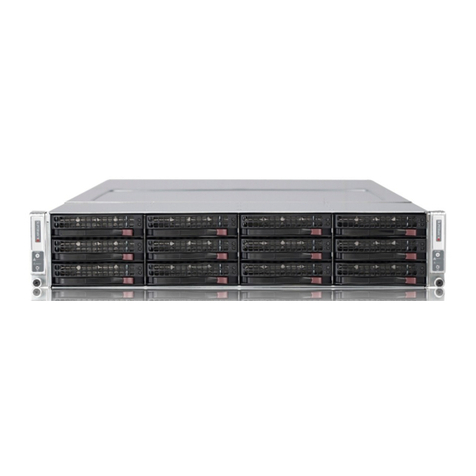
Supero
Supero SUPERSERVER 2027TR-D70RF+ user manual
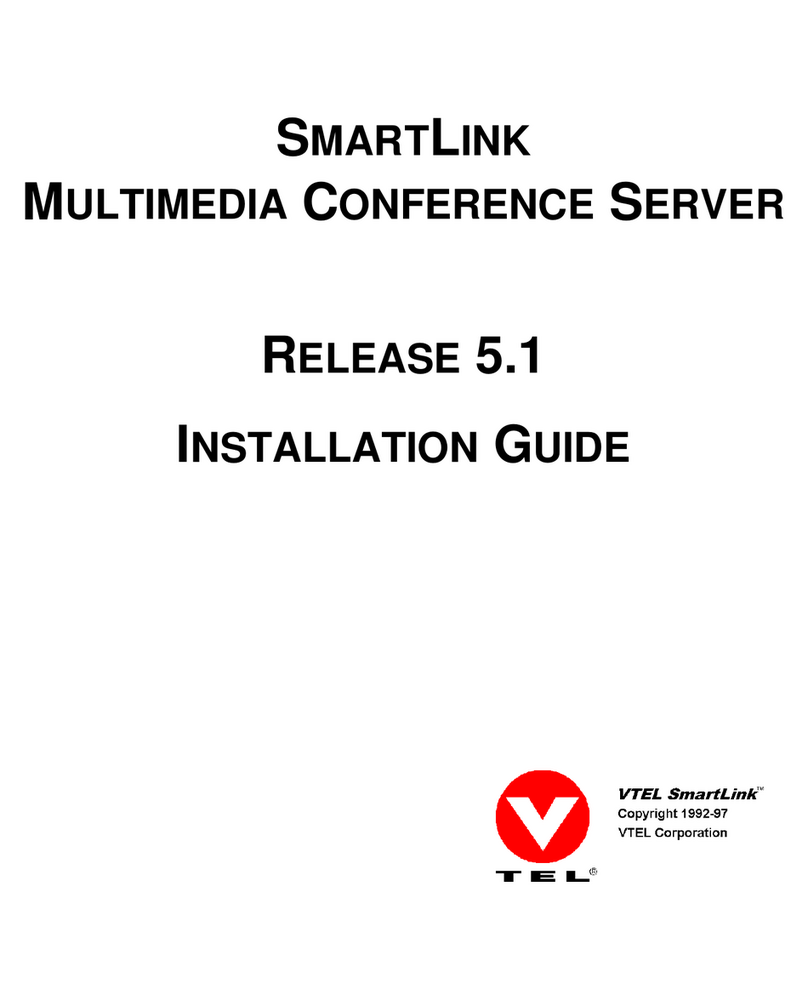
Smartlink
Smartlink Multimedia Conference Server installation guide
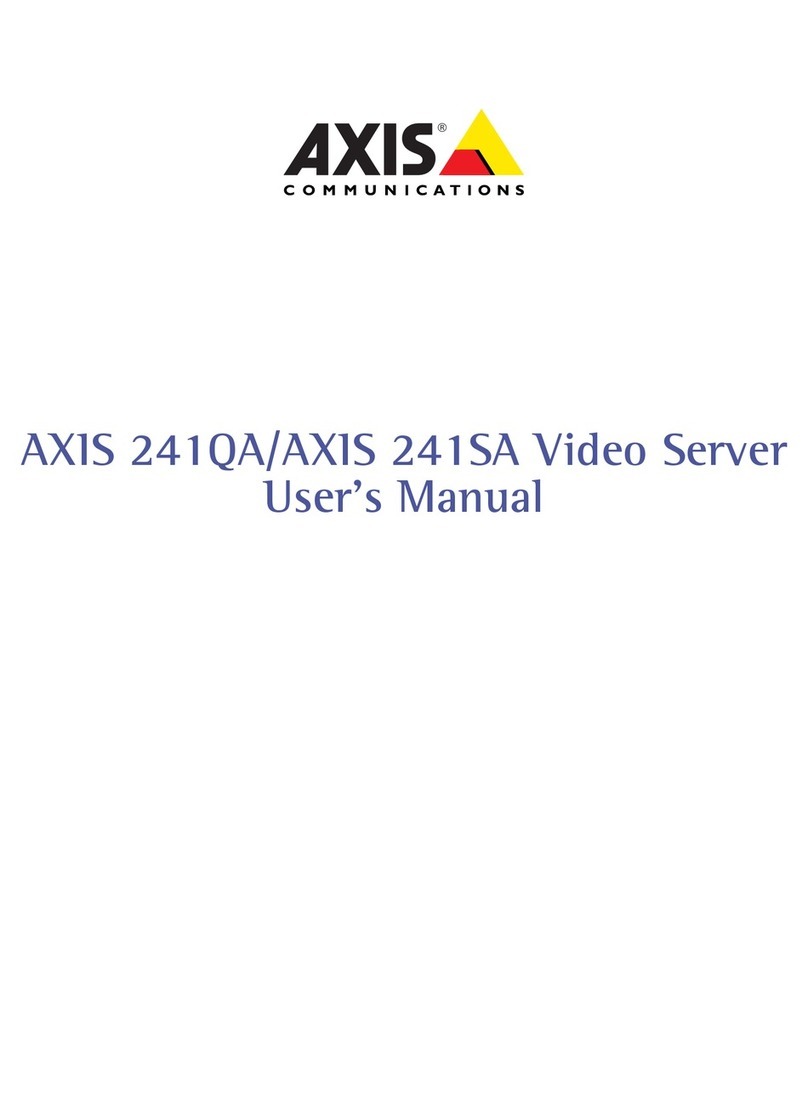
Axis
Axis Video Server AXIS 241SA user manual

TYAN
TYAN GT86A-B7051 Service engineer's manual
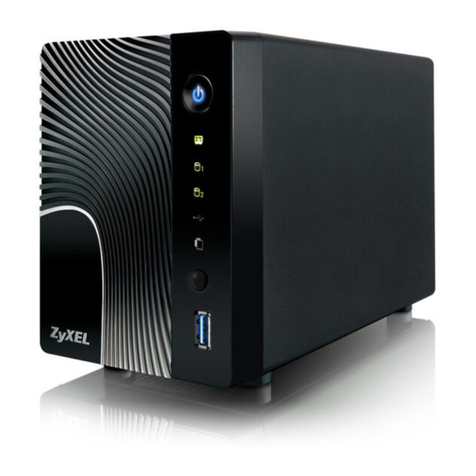
ZyXEL Communications
ZyXEL Communications NSA325 user guide
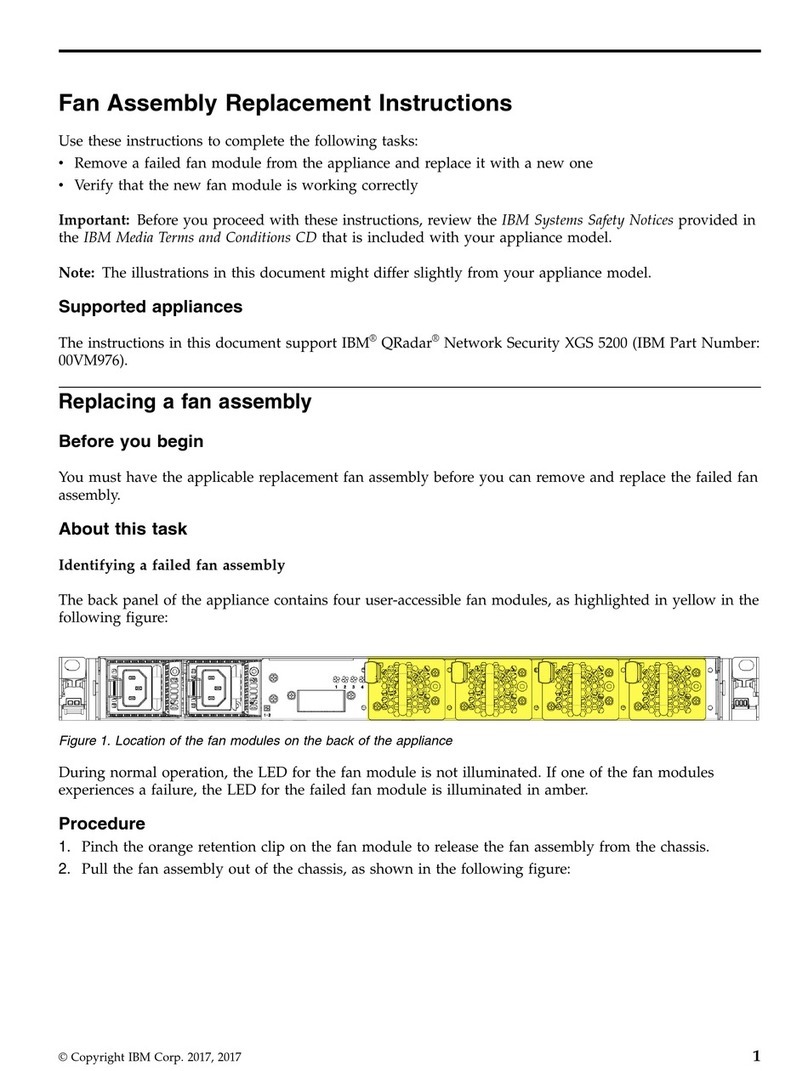
IBM
IBM XGS 5200 Assembly instructions
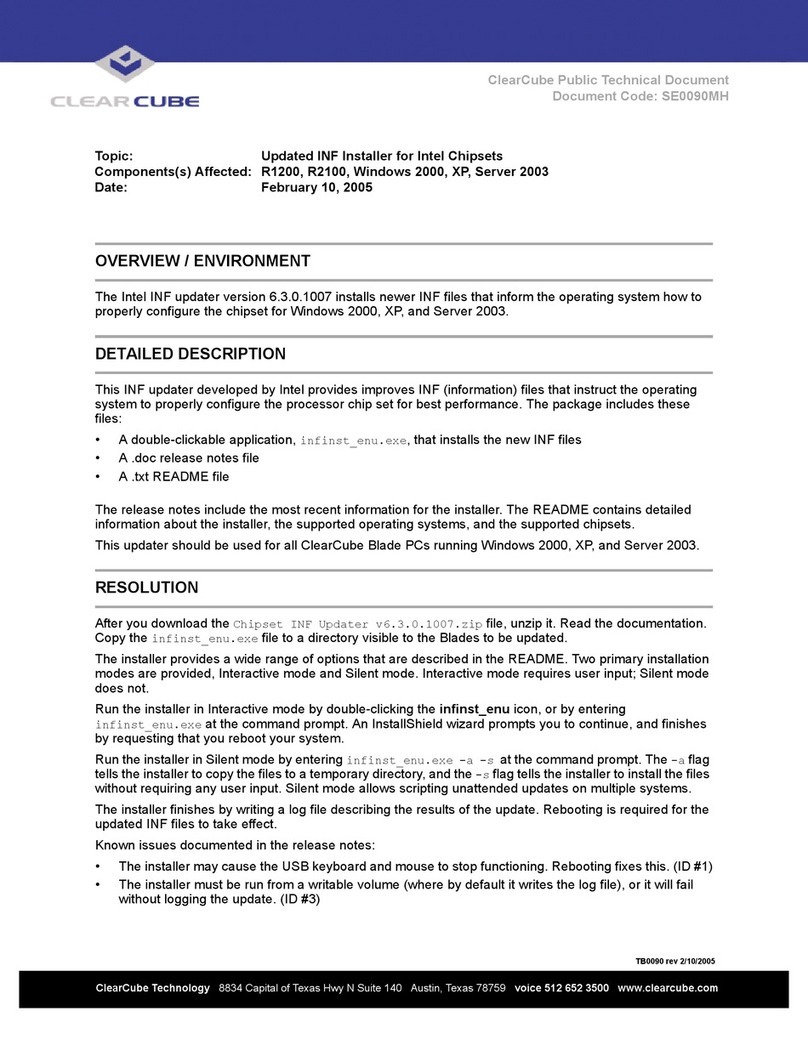
ClearCube
ClearCube R1200 Technical document

Helwett Packard
Helwett Packard ProLiant DL365 Maintenance and service guide
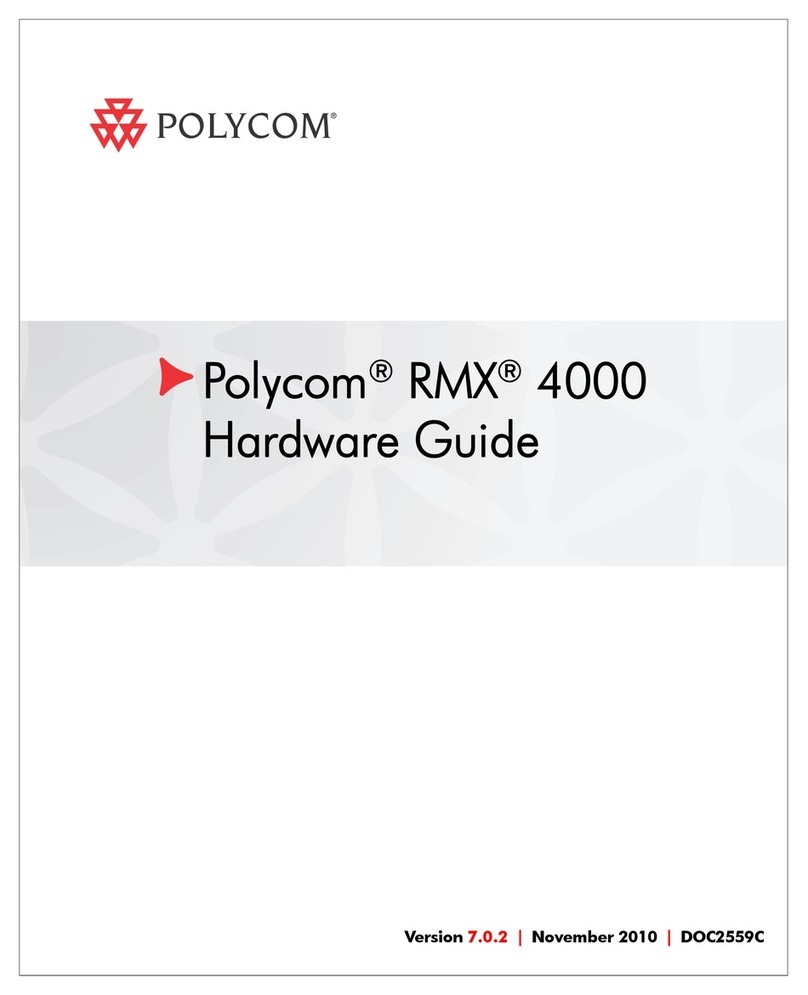
Polycom
Polycom DOC2559C Hardware guide

Uniwide Technologies
Uniwide Technologies XtremeServer 1322 user guide
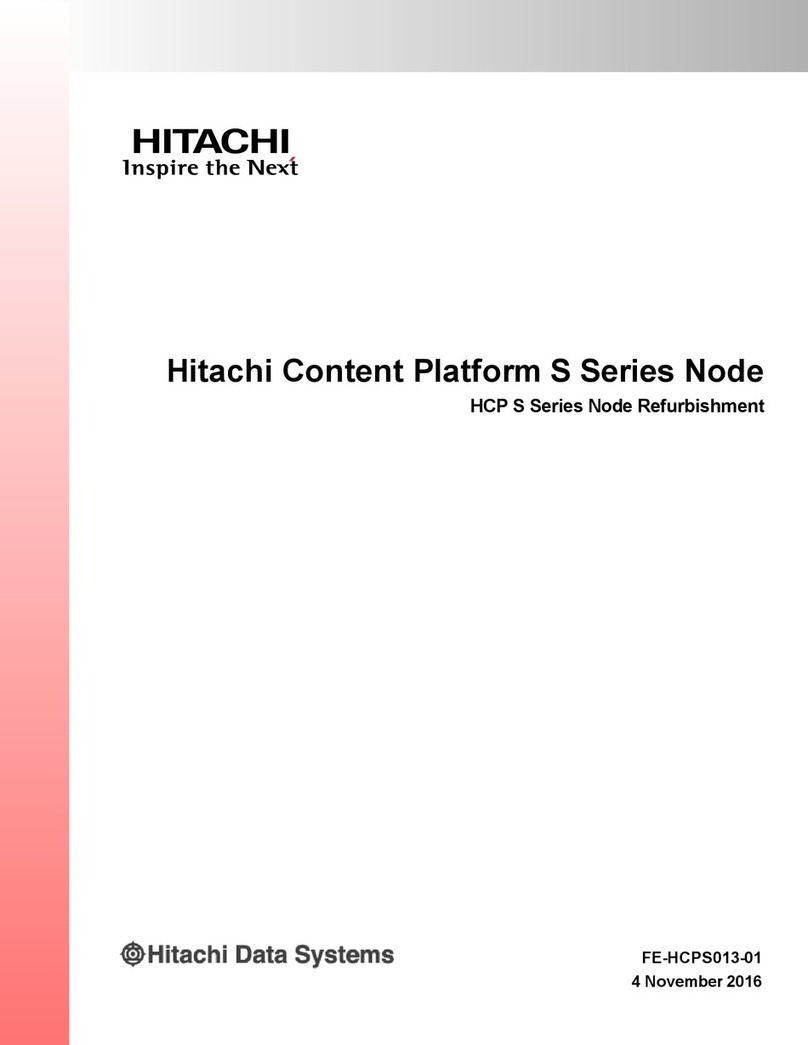
Hitachi
Hitachi Content Platform S Series manual
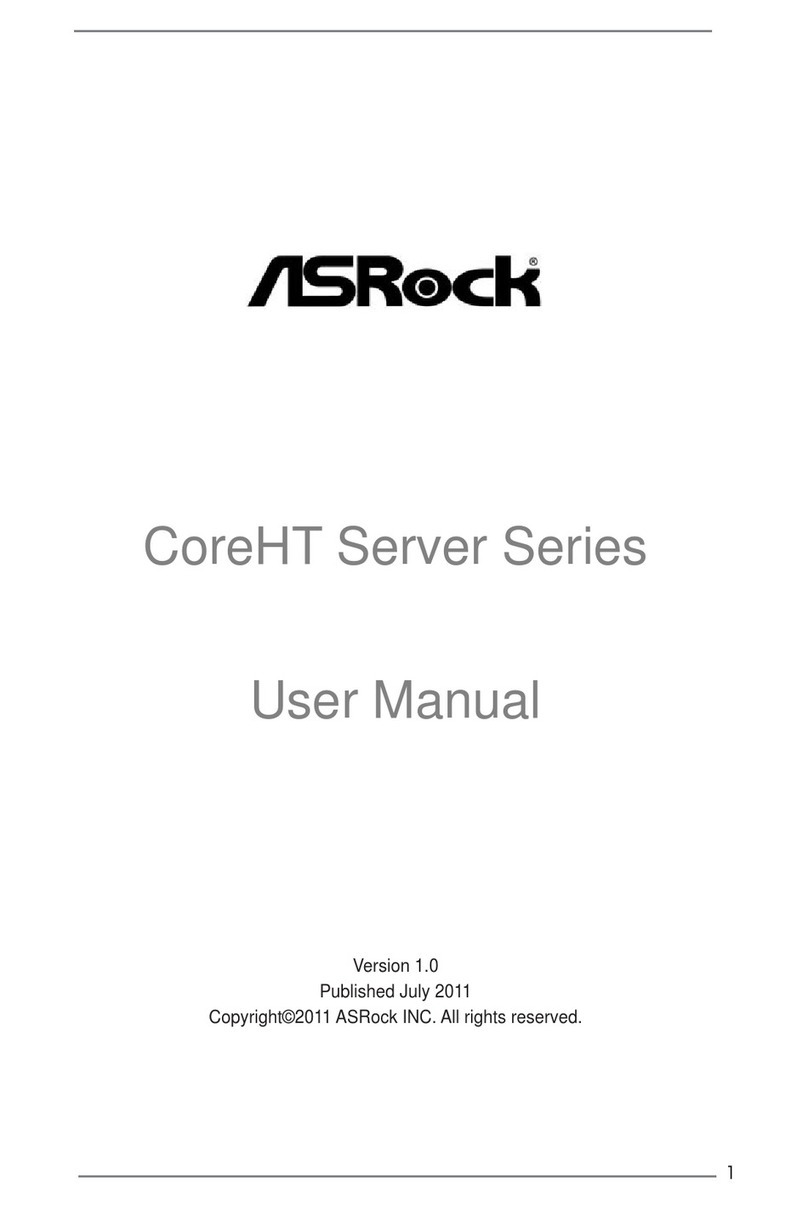
ASROCK
ASROCK CoreHT user manual
